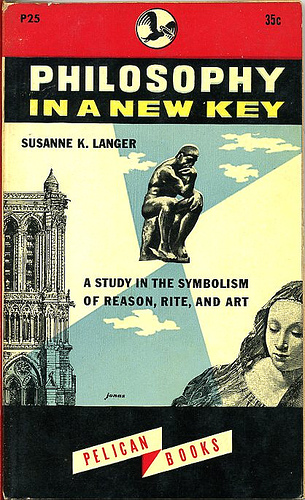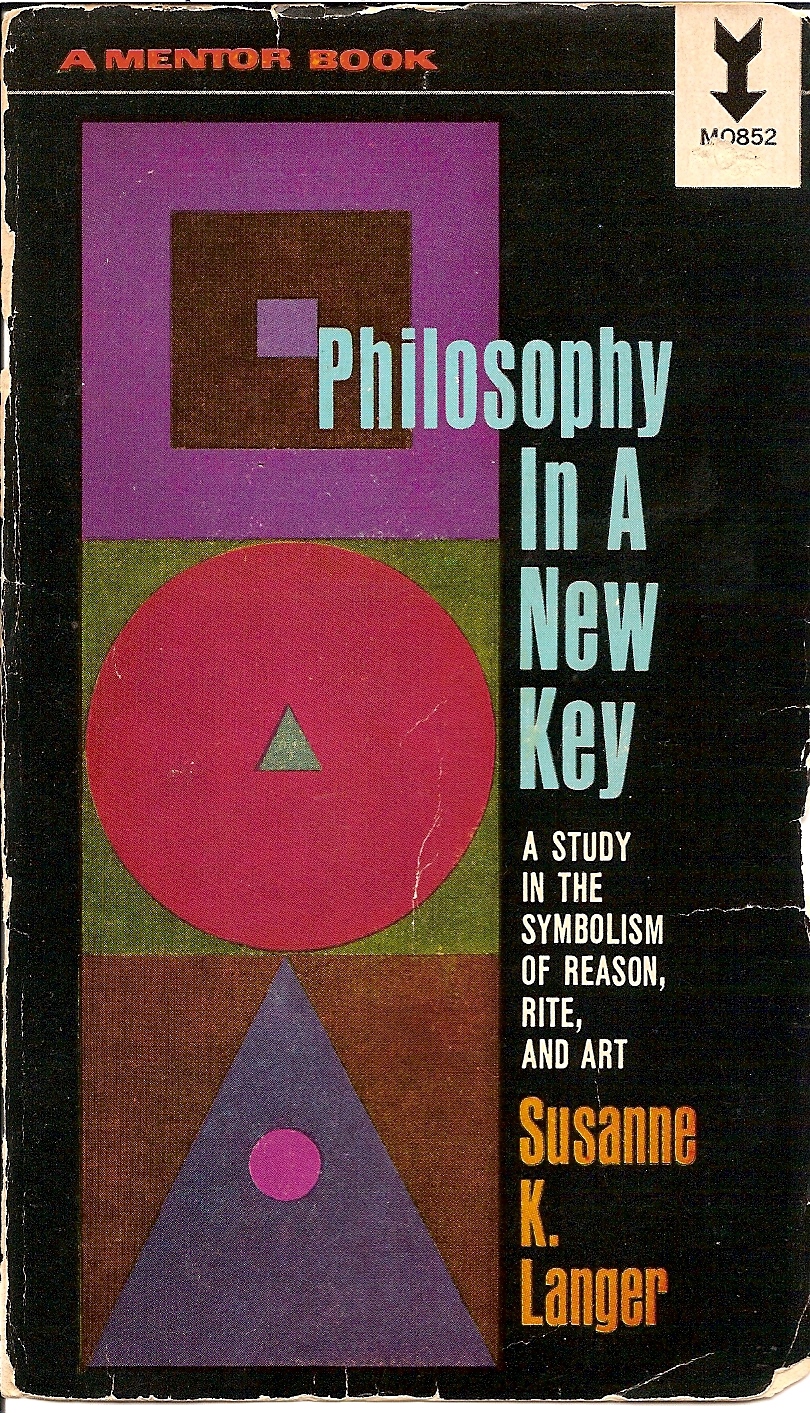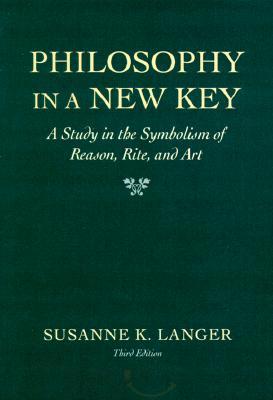
AnthonyFlood.com
Panentheism. Revisionism. Anarchocapitalism.



Prefaces to the three editions of Philosophy in a New Key: A Study in the Symbolism of Reason, Rite and Art, published in 1941, 1951, and 1956, respectively. Langer dedicated the work “To Alfred North Whitehead, my great Teacher and Friend.” (In the first preface, he is “the sage to whom this book is dedicated.”)
Prefaces to the Three Editions of
Philosophy in a New Key
Susanne K. Langer
Preface to the First Edition
The “new key” in Philosophy is not one which I have struck. Other people have struck it, quite clear-ly and repeatedly. This book purports merely to de-monstrate the unrecognized fact that it is a new key, and to show how the main themes of our thought tend to be transposed into it. As every shift of tonal-ity gives a new sense to previous passages, so the reorientation of philosophy which is taking place in our age bestows new aspects on the ideas and argu-ments of the past. Our thinking stems from that past, but does not continue it in the ways that were fore-seen. Its cleavages cut across the old lines, and suddenly bring out new motifs that were not felt to be implicit in the premises of the schools at all; for it changes the questions of philosophy.
The universality of the great key-change in our thinking is shown by the fact that its tonic chord could ring true for a mind essentially preoccupied with logic, scientific language, and empirical fact, al-though that chord was actually first sounded by thinkers of very different school. Logic and science had indeed prepared the harmony for it, unwittingly; for the study of mathematical “transformations” and “projections,” the construction of alternative des-criptive systems, etc., had raised the issue of sym-bolic modes and of the variable relationship of form and content. But the people who recognized the im-portance of expressive forms for all human under-standing were those who saw that not only science, but myth, analogy, metaphorical thinking, and art are intellectual activities determined by “symbolic modes”; and those people were for the most part of the idealist school. The relation of art to epistemo-logy was first revealed to them through reflection on the phenomenal character of experience, in the course of the great transcendentalist “adventure of ideas” launched by Immanuel Kant. And, even now, practically all serious and penetrating philosophy of art is related somehow to the idealistic tradition. Most studies of artistic significance, of art as a sym-bolic form and a vehicle of conception, have been made in the spirit of post-Kantian metaphysics.
Yet I do not believe an idealistic interpretation of Reality is necessary to the recognition of art as a symbolic form. Professor Urban speaks of “the as-sumption that the more richly and energetically the human spirit builds its languages and symbolisms, the nearer it comes . . . to its ultimate being and reality,” as “the idealistic minimum necessary for any adequate theory of symbolism.” If there be such a “Reality” as the idealists assume, then access to it, as to any other intellectual goal, must be through some adequate symbolism; but I cannot see that any access to the source or “principle” of man’s being is presupposed in the logical and psychological study of symbolism itself. We need not assume the presence of a transcendental “human spirit,” if we recognize, for instance, the function of symbolic transformation as a natural activity, a high form of nervous re-sponse, characteristic of man among the animals. The study of symbol and meaning is a starting-point of philosophy, not a derivative from Cartesian, Hu-mean, or Kantian premises; and the recognition of its fecundity and depth may be reached from various positions, though it is a historical fact that the ideal-ists reached it first, and have given us the most illu-minating literature on non-discursive symbolisms—myth, ritual, and art. Their studies, however, are so intimately linked with their metaphysical specula-tions that the new key they have struck in philosophy impresses one, at first, as a mere modulation within their old strain. Its real vitality is most evident when one realizes that even studies like the present essay, springing from logical rather than from ethical or metaphysical interests, may be actuated by the same generative idea, the essentially transforma-tional nature of human understanding.
The scholars to whom I owe, directly or indirectly, the material of my thoughts represent many schools and even many fields of scholarship; and the final ex-pression of those thoughts does not always give cre-dit to their influence. The writings of the sage to whom this book is dedicated receive but scant expli-cit mention; the same thing holds for the works of Ernst Cassirer, that pioneer in the philosophy of sym-bolism, and of Heinrich Schenker, Louis Arnaud Reid, Kurt Holdstein, and many others. Sometimes a mere article or essay, like Max Kraussold’s “Musik und Mythus in ihrem Verhältnis” (Die Musik, 1925), Éti-enne Rabaud’s “Les hommes au point de vue biolo-gique” (Journal de Psychologie, 1931), Sir Henry Head’s “Disorders of Symbolic Thinking and Expres-sion” (British Journal of Psychology, 1920), or Her-mann Nohl’s Still und Weltanschauung, can give one’s thinking a new slant or suddenly organize one’s scat-tered knowledge into a significant idea, yet be com-pletely swallowed up in the theories it has influenced so that no specific reference can be made to it at any particular point of their exposition. Inevitably, the philosophical ideas of every thinker stem from all he has read as well as all he has heard and seen, and if consequently little of his material is really original, that only lends his doctrines the continuity of an old intellectual heritage. Respectable ancestors, after all, are never to be despised.
Though I cannot acknowledge all my literary debts, I do wish to express my thanks to several friends who have given me the benefit of their judgment or of their aid: to Miss Helen Sewell for the comments of an artist on the whole theory of non-discursive sym-bolism, and especially on chapters 8 and 9; to Mr. Carl Schorske for his literary criticism of those same long chapters; to my sister, Mrs. Dunbar, for some valuable suggestions; to Mrs. Dan Fenn for reading the page proofs, and to Miss Theodora Long and my son Leonard for their help with the index. Above all I want to thank Mrs. Penfield Roberts, who has read the entire manuscript, even after every extensive revision, and given me not only intellectual help, but the constant moral support of enthusiasm and friendship, confirming for me the truth of what one lover of the arts, J. M. Thorburn, has said—that “all the genuine, deep delight of life is in showing people the mud-pies you have made; and life is at its best when we confidingly recommend our mud-pies to each other’s sympathetic consideration.”
S. K. L.
Cambridge, 1941
Preface to the Second Edition
In offering Philosophy in a New Key to the public once more, this time to a larger part of the English-speaking world, I have made no changes (except for small corrections) in the original text. After nine years one naturally sees the imperfections of a work and wishes it were better; but so long as one can still subscribe to its contents as a whole it is more important, perhaps, to carry the intellectual venture forward than to revise small details of its first formulation.
Modern theory of knowledge, leading naturally to a critique of science, represents the best philosophical work of our time. But “knowledge” is not synony-mous with “human mentality.” It is the intent of this book to establish a theory of mind which shall support that excellent treatment of science, and furthermore lead to an equally serious and detailed critique of art. Chapters 8 and 9—“On Significance in Music” and “The Genesis of Artistic Import”—purport to point the way to that second inquiry. They are, of course, no more than preliminary and limited studies, and do not establish the power of the premises here assumed to cope with the entire problem of the nature and structure of art; but they assay new ground.
A book which is the beginning of a line of thought can be judged only in retrospect, when the relative importance of its several ideas emerges by virtue of the further developments of which they show them-selves capable and any major defects in their foun-dations have had time to come to light. In the years which have elapsed since the first edition of this book appeared, I have put its general tenets to the test by working out the philosophy of art they promised, and so far I have found them amazingly fertile, leading from novelty to novelty in a realm of theory that has long been imponderable or purely academic. It is with this pragmatic assurance, therefore, that I reaffirm my little work by offering it to the public once more in unaltered form.
If, however, I were writing it now, there would be at least one difference in terminology, affecting es-pecially Chapter 3, “The Logic of Signs and Symbols”; that chapter heading would read “The Logic of Signals and Symbols.” Charles Morris, in his Signs, Language and Behavior, employed a usage which I find superior to my own and have accordingly adopted since the publication of his book. Morris uses the word “signal” for what I called “sign.” The term “signal” is stretched, of course, to cover not only explicitly recognized signals—red lights, bells, et cetera—but also those phenomena which we tacitly respect as signals to our sense, e.g. the sight of objects and windows whereby we are oriented in a room, the sensation evoked by a fork in a person’s hand that guides him in raising it to his mouth; in short, to cover everything that I called “sign.” But such a stretching of a semi-technical term is easily accepted and perfectly legitimate. The great advantage of Morris’s usage is that it leaves us the word “sign” to denote any vehicle of meaning, signal or symbol, whereas in my own vocabulary there was no generic term, and the need of it was sometimes obvious.
Another, intellectually much more important, change I should like to make, if I could have twenty-four hours’ “second chance” like Sartre’s shades from Limbo, is to replace the unsatisfactory notion of music as an essentially ambiguous symbol by a much more precise, though somewhat difficult, concept of musical significance, involving a theory (not yet quite completed) of artistic abstraction in general. This I would consider a distinct advance in the theory of art as “expressive form”; but it has to wait upon the later elaboration of certain ideas that are still young and therefore half poetic in Philosophy in a New Key. The process of philosophical thought moves typically from a first, inadequate, but ardent apprehension of some novel idea, figuratively ex-pressed, to more and more precise comprehension, until language catches up to logical insight, the figure is dispensed with, and literal expression takes its place. Really new concepts, having no names in cur-rent language, always make their earliest appear-ance in metaphorical statements; therefore the be-ginning of any theoretical structure is inevitably marked by fantastic inventions. There is an air of such metaphor, or “philosophical myth,” in the treat-ment of musical “meaning,” which I think I could improve on were I given another fling at it today.
Yet perhaps not; perhaps, in the course of render-ing that mild extravaganza more literally and logic-ally, one would necessarily raise new issues, which again would invite the imagination to project their answers in a tentative, figurative way; for all the vastly ramified questions of art—of creation, ab-straction, and import—are still in the offing. So it may be wiser to let the book go out just as it was before, even with its unfinished thoughts and half-spoken answers, instead of tinkering with any part. A book is like a life: all that is in it is really of a piece. Les feux sont fait.
S. K. L.
Columbus, Ohio
May 7, 1951
A Prefatory Note to the Third Edition
Five years ago, when the second edition of Philoso-phy in a New Key appeared, the book had already taken on, for its author, the character of a prolego-menon to a larger work. A decade had elapsed since its composition, and in that time the theory of music proposed in Chapter VIII had undergone a considerable expansion and had, indeed, grown into a philosophy not only of music, but of all the arts. But this change of character was, as yet, only for the author; the philosophy of art had not appeared in print. Since then it has met its public, and Philosophy in a New Key now is frankly a prelude to Feeling and Form.
Now; what is “now”? We cannot step twice into the same river. We cannot arrest a day, a melody, or a thought. Now, even as the third edition goes to press, the philosophy of art here engendered has in turn become a mere station in the progress of ideas. These ideas, tentative and imperfect as their expres-sion in this first book had to be, now promise to transcend the realm of “aesthetics” (to use the unfortunate current word), and lead us to a new philosophy of living form, living nature, mind, and some of the very deep problems of human society that we usually designate as ethical problems. In the course of such a long development they are sure to undergo changes, like babies grown into men, whose fading snapshots in the family album are hard to reconcile with their football frowns or Rotarian smiles in the newspaper today. Some readers, therefore, who are dissatisfied with many things in this book, may find some misgivings allayed if they pursue the development of certain paradoxical or arbitrary-sounding assertions through their subsequent his-tory; others, who like forensic argument, will trium-phantly find that the earlier and later versions of many a concept are inconsistent, so the whole philo-sophy goes down refuted. But consistency should be demanded only within the compass of a book, including, of course, whatever former work is reaffirmed in it; between two distinct phases of a long thought, improvement is more important, even if it amounts to self-reversal.
So Philosophy in a New Key goes out once more, still the beginning of an unfinished story, but also still its indispensable prologue. It contains the founda-tions of Feeling and Form, and whatever, with good fortune, may follow from that philosophical excursion into the arts; and above all, it still proclaims the work of a brilliant, though strangely assorted, intellectual generation — Whitehead, Russell, Witttgenstein, Freud, Cassirer, to name but a few — who launched the attack on the formidable problem of symbol and meaning, and established the keynote of philoso-phical thought in our day.
S. K. L.
November, 1956
Langer main page